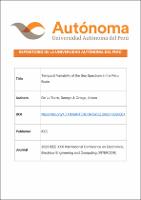Temporal Variability of the Sea Spectrum in the Peru Basin

View/
Author(s)
De La Torre, Dennys
Ortega, Arturo
Date
2023Subject
Metadata
Show full item recordPublisher
IEEE
Journal
2023 IEEE XXX International Conference on Electronics, Electrical Engineering and Computing (INTERCON)
Abstract
The current shortcoming in the development of wave energy technology is the shortage of available ocean data. To manage the lack of ocean data, theoretical assumptions are usually considered. These reasonable assumptions like adopting a standard spectrum have been applied in many wave energy resource assessments. These assessments relied on a specific standard spectrum like JONSWAP or Bretschneider to model wave parameters. However, the shape of these theoretical spectra is characterised by a single peak. As the Peru Basin is an open maritime zone mostly without islands, there should be significant spectral shape variability due to several wave systems like swells and wind waves, making its spectral shape not present a single peak. Thus, this particular spectral shape should represent the sea states in the Peru Basin more accurately than the standard spectra. This work aims to demonstrate that the spectral shape in the Peru Basin has significant variability throughout the year and according to the distribution of the classes of annual energy contribution. This work uses spectral data provided by ocean buoys in the Peru Basin. The wave parameters are modelled using the spectral method and assuming the standard Bretschneider spectrum, which only considers one wave system, to represent the open maritime zone. These results then contrast with the actual average spectral shape of the Peru Basin. The paper concludes that the Peru Basin’s spectral shape only partially matches the regularly used Bretschneider spectrum—the spectral shape changes during the year from single to bimodal. The spectral shape also changes according to the classes of energy period and significant wave height, having one or two energy modes or wave systems. Thus, the peak period is far correlated to the zero-up-crossing period, and its actual relationship does not follow the theoretical assumption based on the Bretschneider spectrum. It is important to study the actual spectral shape variability and compare its shape against standard spectra to verify their agreement. This study is crucial for designing wave energy converters, which are regularly designed based on standard spectra.
Type
info:eu-repo/semantics/article
Rights
info:eu-repo/semantics/restrictedAccess
Language
eng
Collections
- Ingeniería Ambiental [82]

